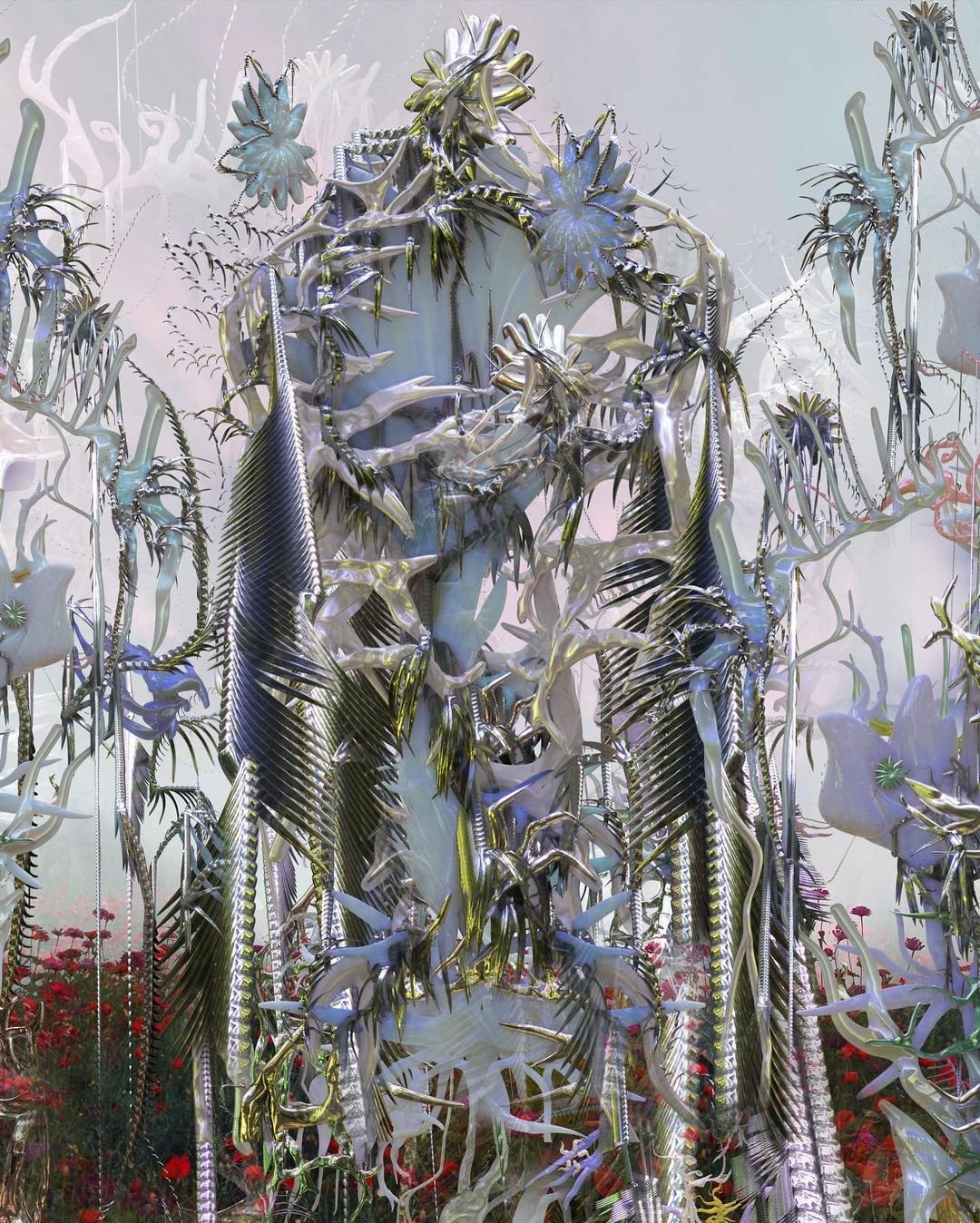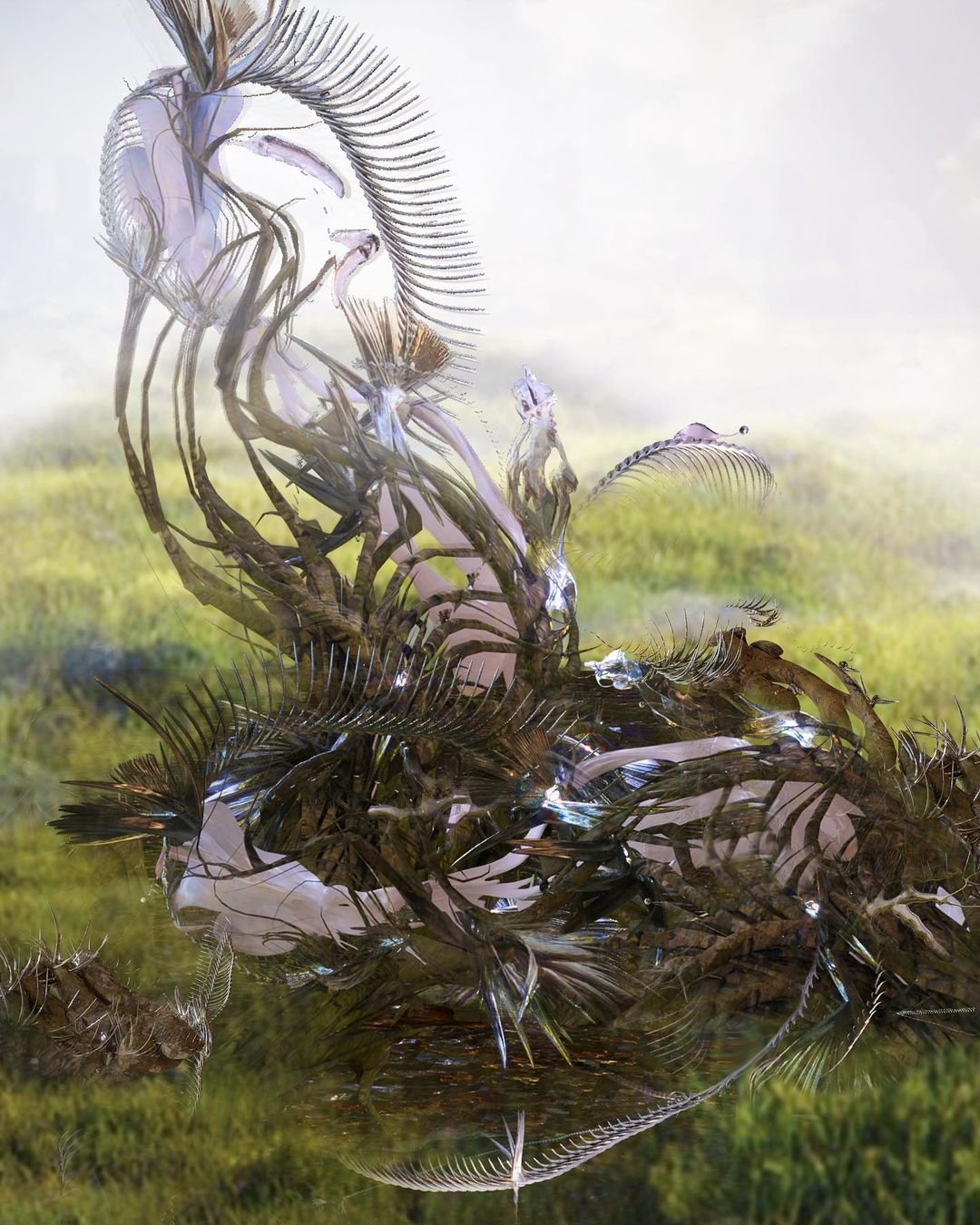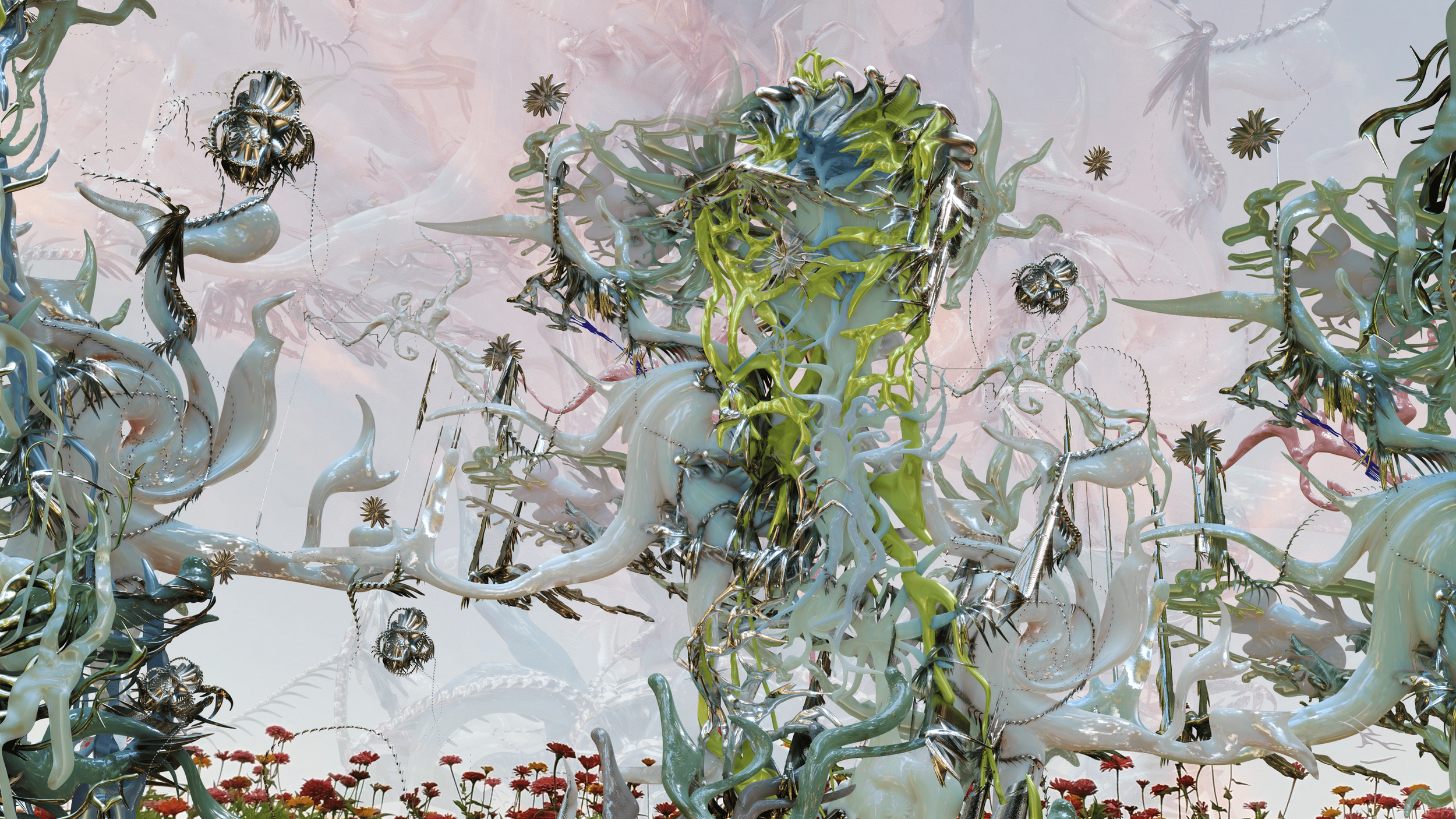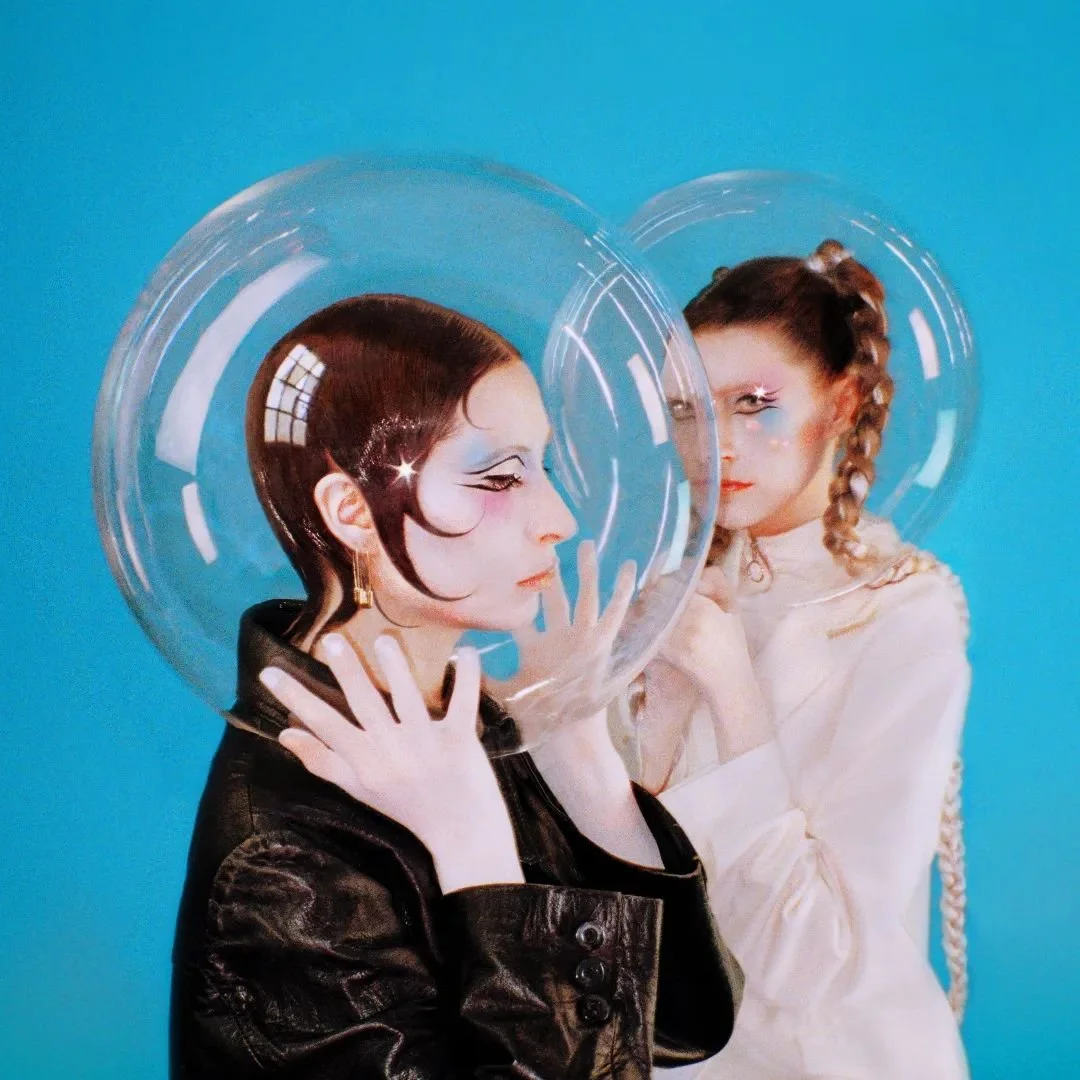Andrea Miu
Andrea's artistic journey encompasses a diverse range of themes, combining classical art foundations with surrealistic ideas, while embracing the fusion of imagination, technology, ecology, and the search for connections within the present biosphere coming together through digital art.
Greetings Andrea, can you please introduce yourself? Where are you from? How long have you been designing? How did you start?
I think I'm far from a designer because all I do is create fictional scenarios because I love stories and surreal ideas. I'm a bit of a weaver. I have a classical art background and have been lucky enough to attend a few residencies and internships across Europe. I'm from Prague, and somehow I'm wandering all over Europe, currently located in Berlin. In the past, I've been particularly interested in the themes of beauty, alienation, the end of the world, the post-internet and above all the direction of thought of Accelerationism, which can be defined as a futurological movement of thought that deals with the future of a post capitalist society. The fundamental idea is based on the belief that the only way out of the current economic and creative decline is through accelerating social development, a more effective use of contemporary technology and social possibilities. This immaterial and decentralized state of affairs has led me to my current theme, which is the search for this sense of awareness of a certain singularity and connection not through the machine but through the biosphere in the present. Which probably holds the answers for a more manageable development not through acceleration but comprehension. I started to focus more on the processes that are already underway, which in a way are close to mythology and going back to the beginning - to the Gaia.
Your art is characterized by crystalised shapes that seem natural and mechanical at the same time. Each expressing its own identity. What is the inspiration behind your aesthetic and style?
The Godless Milieu, the title of my current project and research, describes a mythical universe where life is constantly reshaped through the prism of imagination and is in a constant flux of new entanglements. I’m addicted to stories and imagination. It’s a free environment rich in opportunities where everyone can change, transform, or adopt a different identity. It’s also an allegory of modern life in which objects are the result of a clash between a misinterpretation of nature and its interaction with technology, so a concern for ecology and the ongoing, unmeasured changes between nature and humans also play a significant role. I present new alliances between species and worlds colonized by fluid hybrid(s), diversified beings that have undergone dramatic mutations due to technological pressure and reshaped subjectivities, hierarchies, and anatomy. My interest focuses on plants and the vast biosphere, I think about protective materials and armor for plants woven from metal and create new positions to be taken and new places to live in. I combine old dream techniques from surrealism and romanticism with new media that allow me to combine this new world, as I understand the images of contemporary times with machines. I do not foresee the collapse of anthropocentrism, rather, I celebrate a new union with non-human, plant, and earthly territories, where kinship between species, between the organic and the inorganic, between the living and the inanimate, is cultivated. I explore questions of when the very existence of the species is threatened and how the concept of human x nature is transformed by the creation of a new mythology. What is life, and what separates plants from animals, humans from nonhumans? What are our obligations to the natural world, to other humans, and to other living creatures? Can life merge into one, and can we really feel that we are inside life itself?
Can you tell us more about the poems that are posted alongside your digital art?
It's a way of contextualizing and grounding the whole dream and placing it in the temporal realm. Somehow I don't understand the concept of time, and I need a tool to help me separate these thoughts from each other. Writing and describing something helps me end a scene, and also, by writing it down, it becomes easier to realize whether what I did was what I wanted to do, because it often isn’t, and I'm not very good at getting the images out of my head through my hands and machines and into the form I see them. So I'm still describing them subsequently, and they're kind of notes for me. I like to write, I make lists, I make up new words, I remember people by what they write because it feels somehow real to me. Quite often, my friends get long messages and unsolicited heartfelt letters. No feeling is final.
Can you explain how your creative process works?
I'm pretty much in a questioning era at the moment. Lately, I've been quite drawn to films where the theme of transformation and shape-shifting comes up, and not just on a physical level, and I'm looking for new expressions of how and why something can change and how it can affect the world around me. Narrative seems like an essential part of understanding. My projects require both a creative component and a research part to gather information and data. Working on a project involves a lot of perception and capturing shapes. Moving around the open space, going into nature, the city, or the outskirts, and looking at or taking photos of different materials, or taking 3D scans. Thinking about the context in which they are taken and how I change the meaning of them is a major part of what makes up the final picture. I'm very keen on understanding how things work and why they do, and I also like multitasking. I get quite overwhelmed by different information from different fields. I'm interested in geography, science, and how the world is perceived from different angles of mentality. I'm pretty picky about which piece of information I like and which one I don't, but when I’m intrigued by something, I'm pretty obsessed and need to know as much as I can about the topic, and it becomes my only new passion.
Which tools do you use to produce your work?
My tools for creating digital artworks are photography, 3D scans, and 3D software. For rendering, I use render engines or farms. Sometimes I use AI software for creating structures or when I want to try a new reference.
What do you think about the transformation going on in the art world with the incorporation of Artificial Intelligence image generation? Is this something that you would be interested in trying out? What impact do you think it will have?
The most uncanny part to me is that if it were a brand new thing, no one would understand it. Innovation and continuity in one. Without elements of the past, we wouldn't be able to understand it at all. At the same time, maybe the algorithmic turn is different from the original images in some ways. I think AI has a good understanding of how to represent organic shapes in a way that we haven't explored yet. That's refreshing because it's hard to imagine what we've never seen. Especially for the twisted and nested ones, for inorganic shapes and architecture, the resulting image is quite faithful and fits the current understanding. AI works well for me as far as a replicant of materials and surfaces. I use Deep Learning for the structures of my sculptures, when I want to add some obviously alien element, but because it's often a normal, diffuse, roughness map, it's not really noticeable in the final visual, it's just a scratch that only me and AI know about. We use AI as an extension, as a tool, but I think it could help us in the future with the expansion of our senses, when we won't need any more devices for VR and AR and we’ll be able to see it without it. Maybe some expansion on the direction of teleportation, bringing the dream into the real world where it can echo. It's always a combination. That's a very interesting thing about the history of visual culture. In the eight hundred years of the Byzantine Empire, its style of image-making didn't change. That's why, by the way, you rarely read about specific artists in the history of Byzantine art, because they all did the same thing. Throughout history, there have been alternating periods of slow and rapid change. Perhaps we’re at a turning point in representation, which we will then call a new epoch, separate from the previous portraiture. It would be fascinating to feel the time when the singularity occurs.
What would you like to say to aspiring artists inspired by your work?
I think it's good to go with books that help you understand the whole context of why someone wants to create images in the first place and why someone wants to look at them. I would then look for inspiration on the subject matter and the reason why or why We’re creating, because I think the process is the moment that brings the final work to life and another reason to continue. In the world of digital technology, everything can seem fast, and finding your own reason and aesthetic across different interpretations can be difficult. Go out and talk to people who share your interests; make a cluster; go into nature. Don't overthink it.
The idea is the key.
What's in store for the future? Do you have any exciting projects coming up?
I've been mostly immersed in what's on the surface, the materials, the structures, and their intertwining, and I think now I've become interested in what's on the inside. The anatomy and arrangement of potential plant skeletons and organisms, and visualizing how it could all look and function. Through their inner world I can imagine the organs through which they communicate and have their own language, so I’m thinking about some interspecies linguistics. I’d also like to create some tools and prosthetics that would complement this world, I’m thinking about using 3D printing to bring this inner world into a material form.
interview CAROLINA SANCHEZ
What to read next

















